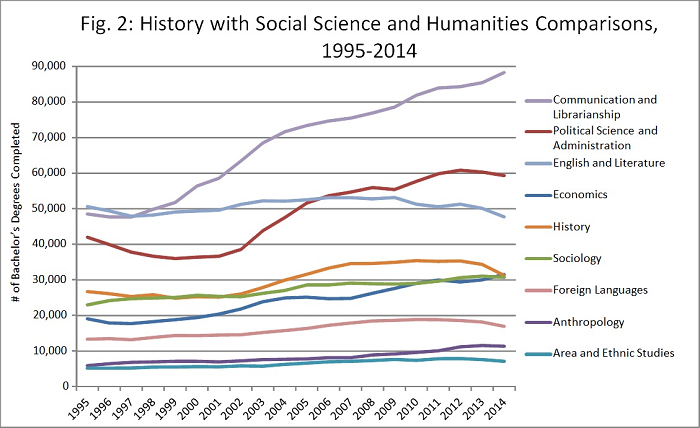But wait, it gets worse. A study from the American Academy of Arts & Sciences reports an even bigger decrease of 12 percent for 2014. (There is as bit of a lag in collecting the data; 2014 might be two years ago, but it is as up-to-date as we are going to get in 2016).
These numbers, according to on-going studies that the AHA is conducting, are part of a larger pattern. “The available information suggests that the 2014 completion data is more likely than not one step in a downward trend that will play out unevenly across undergraduate programs over the next two to three years.” Reasons for these declines vary. My take is that significant increases in the cost of going to college and the weak economy have had a significant role in the decision making of undergraduates and their families. If a college degree is going to going to cost $100,000 and require an individual student to go into significant debt, then they would rather do that for an engineering degree, or one in marketing, or finance where there is a more tangible return on investment. The following chart, taken from Perspectives on History and based on the Center for Education Statistics study, shows that the humanities degrees that are bettered coordinated to professional careers than history (economics, journalism/communications, and political science—often seen as a pre-law degree) are doing better in enrollment numbers:
 Another study documents a second trend at play in higher education. An AHA study shows that students in history Ph.D. programs are increasing. In 2014 there was a 2.3 percent increase. The study breaks down the numbers looking at topics: U.S. history dominates (no big surprise) with European history a clear second.
Another study documents a second trend at play in higher education. An AHA study shows that students in history Ph.D. programs are increasing. In 2014 there was a 2.3 percent increase. The study breaks down the numbers looking at topics: U.S. history dominates (no big surprise) with European history a clear second.The problem with these studies is that these trends are moving in the exact opposite direction that they need to move. There are many posts on this blog and articles elsewhere that make it clear that the supply of Ph.D. exceeds demand. But in the near future that supply is going to increase, and the demand for them to teach undergraduates is going to decrease. The leadership of the historical profession needs to begin looking at ways to turn both trends around. Individual scholars need to be aware of their current direction and plan their future careers accordingly







No comments:
Post a Comment